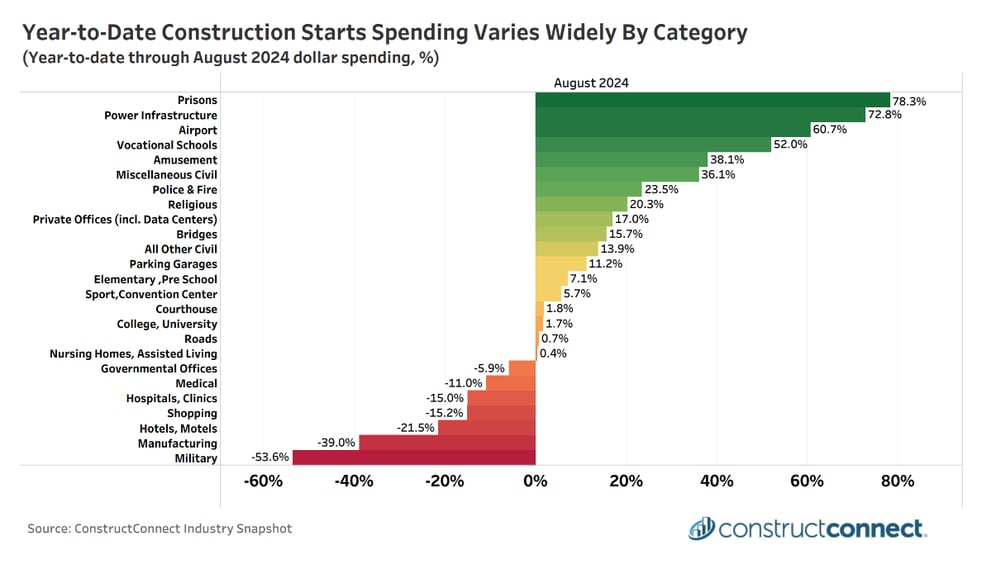As we enter the final months of 2024, we are beginning to see a clearer picture of where category results for nonresidential construction starts spending could finish for the year.
Through August, total year-to-date construction spending is down 2.4%. However, this small contraction hides a wide dispersion of results across categories as shown in the chart below.
While prisons are one of our smaller dollar-spend categories, they achieved astonishing growth in 2024, in part thanks to a small number of extremely valuable starts.
Power infrastructure has experienced tremendous growth due to the electrification of the economy and the preference for green energy projects. As the US becomes a more intensive user of electricity over other forms of energy, it is little surprise that power infrastructure is near the top of our list.
Private offices, which have grown 17% year-to-date, contradict the work-from-home trend that continues to elevate office vacancy rates. The reason for this has to do with the inclusion of data centers in this category. As one might expect, data centers are more than offsetting the contraction in spending on actual office starts.

A few categories have struggled thus far in 2024, several of which may be a surprise given their common perception as steady growth markets. Although public spending has been quite strong in 2024—thanks to heavy engineering work propelled by the Federal Government’s stimulus measures, specifically the Infrastructure Investment and Jobs Act or IIJA—government office starts have fallen 6% year-to-date. Coupled with this decline is military spending, which presently sits at the bottom of our list.
Surprisingly, hospitals and clinics, along with manufacturing spending, contracted in 2024. However, in 2022 and 2023, both categories experienced extreme spending surges as the country battled the direct and indirect effects of COVID-19. For this reason, the latest contractionary spending results represent a return to long-run spending trends rather than a worrisome contraction of interest in these construction categories.
In yesterday's article on The Top 10 Project Starts for August, I mentioned that understanding the construction industry's landscape would significantly benefit firms willing and able to navigate today’s bumpy terrain. The starts category data shown here is just one way to add to that understanding.
Read The Construction Economy Snapshot for more insights and analysis by Chief Economist Michael Guckes.
About ConstructConnect
At ConstructConnect, our software solutions provide the information that construction professionals need to start every project on a solid foundation. For more than 100 years, our keen insights and market intelligence have empowered commercial firms, building product manufacturers, trade contractors, and architects to make data-driven decisions, streamline preconstruction workflows, and maximize their productivity. Our newest offerings—including our comprehensive, AI-assisted software—help our clients find, bid on, and win more projects.
ConstructConnect operates as a business unit of Roper Technologies (Nasdaq: ROP), a constituent of the Nasdaq 100, S&P 500, and Fortune 1000.
For more information, visit constructconnect.com.